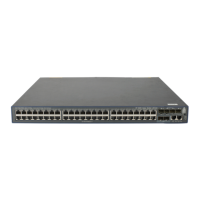144
Ste
Command
Remarks
1. Enter system view.
system-view N/A
2. Enter IS-IS view.
isis [ process-id ] [ vpn-instance
vpn-instance-name ]
N/A
3. Assign convergence priorities
to specific IS-IS routes.
priority { critical | high | medium }
{ prefix-list prefix-list-name | tag
tag-value }
By default, IS-IS routes, except IS-IS
host routes, have the low
convergence priority.
Setting the LSDB overload bit
By setting the overload bit in sent LSPs, a router informs other routers of failures that make it unable to
select routes and forward packets.
When an IS-IS router cannot record the complete LSDB, for example, because of memory insufficiency,
it will calculate wrong routes. To make troubleshooting easier, temporarily isolate the router from the IS-IS
network by setting the overload bit.
To set the LSDB overload bit:
Ste
Command
Remarks
1. Enter system view.
system-view N/A
2. Enter IS-IS view.
isis [ process-id ] [ vpn-instance vpn-instance-name ]
N/A
3. Set the overload bit.
set-overload [ on-startup [ [ start-from-nbr system-id
[ timeout1 [ nbr-timeout ] ] ] | timeout2 ] [ allow { external
| interlevel } * ]
By default, the
overload bit is not
set.
Configuring system ID to host name mappings
A 6-byte system ID in hexadecimal notation uniquely identifies a router or host in an IS-IS network. To
make a system ID easy to read, the system allows you to use host names to identify devices and provides
mappings between system IDs and host names.
The mappings can be configured manually or dynamically. Follow these guidelines when you configure
the mappings:
• To view host names rather than system IDs by using the display isis lsdb command, you must enable
dynamic system ID to host name mapping.
• If you configure both dynamic mapping and static mapping on a router, the host name specified for
dynamic mapping applies.
Configuring a static system ID to host name mapping
Ste
Command
Remarks
1. Enter system view.
system-view N/A
2. Enter IS-IS view.
isis [ process-id ] [ vpn-instance
vpn-instance-name ]
N/A

